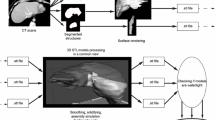Abstract
Background
Hepatectomy for an invisible small tumor using intraoperative ultrasonography requires technical ingenuity. We used a 3D print of a liver to perform a hepatectomy on two patients with synchronous multiple liver metastases from colorectal cancer. Because of preoperative chemotherapy, one of the tumors became smaller and invisible to ultrasonography in each case. We present our procedure here.
Methods
Multidetector-row computed tomography images of anatomical structures were digitally segmented using the original software “PLUTO,” which was developed at the Graduate School of Information Science, Nagoya University. After converting the final segmentation data to stereolithography files, a 3D printed liver at a 70 % scale was produced. The support material was washed and the mold charge was removed from the 3D-printed hepatic veins. The surface of the 3D-printed model was abraded and coated with urethane resin paint. After air-drying, the 3D-printed hepatic veins were colored by injecting a dye. The 3D printed portal veins were whitish because mold charge remained. All procedures after 3D printing were performed by hand.
Results
Hepatectomy for the small tumor that is invisible to intraoperative ultrasonography was performed by referring to a 3D-printed model. The planned resections were successful with histologically negative surgical margins.
Conclusions
The application of a 3D-printed liver to perform a hepatectomy for a small tumor that is invisible to intraoperative ultrasonography is an easy and feasible procedure. Use of 3D-printing technology in hepatectomy requires further improvement and automation of hand work after the 3D print has been made.


Similar content being viewed by others
References
Zein NN, Hanouneh IA, Bishop PD et al (2013) Three-dimensional print of a liver for preoperative planning in living donor liver transplantation. Liver Transpl 19:1304–1310
Ikegami T, Maehara Y (2013) Transplantation: 3D printing of the liver in living donor liver transplantation. Nat Rev Gastroenterol Hepatol 10:697–698
Nimura Y, Deguchi D, Kitasaka T et al (2008) PLUTO: a common platform for computer-aided diagnosis. Med Imaging Technol 26:187–191 (in Japanese)
Loresen WE, Cline HE (1987) Marching cubes: a high resolutuion 3D surface construction algorithm. In: Proceedings of SIGGRAPH, vol 21, pp 163–169
Author information
Authors and Affiliations
Corresponding author
Rights and permissions
About this article
Cite this article
Igami, T., Nakamura, Y., Hirose, T. et al. Application of a Three-dimensional Print of a Liver in Hepatectomy for Small Tumors Invisible by Intraoperative Ultrasonography: Preliminary Experience. World J Surg 38, 3163–3166 (2014). https://doi.org/10.1007/s00268-014-2740-7
Published:
Issue Date:
DOI: https://doi.org/10.1007/s00268-014-2740-7




